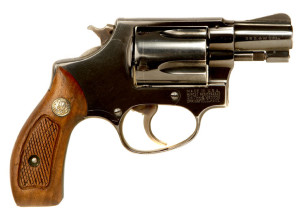 I have just returned from the range. Being somewhat retired now, I can spend more time there than in the past. It is a wonderful thing to be at the range with very few, if any, patrons present in the young hours of the morning.
I have just returned from the range. Being somewhat retired now, I can spend more time there than in the past. It is a wonderful thing to be at the range with very few, if any, patrons present in the young hours of the morning.
I had taken the XDs 4.0 45 for a run; an attempt to get better acquainted with this pistol because I do not fire it often. I slowly emptied the first magazine (5 rounds) while shooting at a distance of 7 yards as a warm-up (yeah, I know that in real life you don’t get a warm-up). I changed out targets and moved the new one out to 10 yards to slow practice the “Mozambique Drill” as quick as I could (which is not fast by any means). The object of which was to concentrate on grip and transitioning the gun from center mass to head. I did have one round just outside the head to the right. Center mass hits were keepers.
A fresh target was mounted and moved to the 15 yard line. I expended several magazines of 239-grain FMJ at this distance and, while not entirely satisfied with the results (I rarely am), all shots were within the body of the target, but I would not have taken any trophies home as a result of my shooting or the rate at which I was shooting. I had one IDPA target left.
I decided to move back to 7 yards and do some fast fire exercises; dump as many rounds in the target as I could as quickly and as accurately as possible. Starting from a high-ready position, I responded to a mental “ding” in my head. When the ding went off, I thrust the XDs out and downloaded five rounds into the “center mass zone” of the target – and stopped. That was when a light bulb went off in my head. Why did I stop (freeze) at five rounds? I had other magazines at my disposal! That’s when I realized that I had jumped back into an earlier shooting habit.
You see, when I seriously started practicing the “Art of Shooting” a long time ago, the only firearm that I had at the time was a Blued Smith & Wesson Model 36; the first quality firearm that I owned. It was impossible to fire more than five rounds of .38 special until I had to reload. Somehow, that fact became ingrained in my memory and popped out during today’s practice session.When shooting stress fire courses later as a LEO, we were instructed how many shots were to be taken at each target; two in this one, three in that one, one in that one – reload – one in this one, three in that one, two in that one – reload! You simply followed instructions. Unknowingly, I had placed restrictions on myself regarding how many rounds are to go downrange. Like qualifying, the restriction is also present during Bulls-eye matches; While you are trying to pump rounds to the target, you are being tested for where you hit on the target and not necessarily the time in which you hit them (although there is a time limit). Thus, I feel, restrictions like this are the bane of competition when applied to real-world situations.
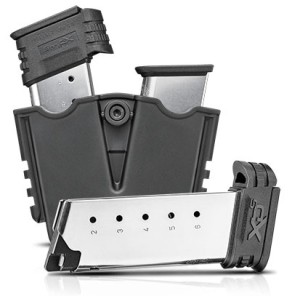 What I learned from today’s shooting session is that I won’t automatically switch on the “Mozambique Drill” in my head, but I will pump five rounds to center mass (or as close to it as I am capable of) as quickly as I can. So, where does that leave me? As they say, “Old habits die hard!” While I may have more rounds available to me, say in a six-shot revolver or higher capacity pistol, my shooting mind was switching off at five rounds!
What I learned from today’s shooting session is that I won’t automatically switch on the “Mozambique Drill” in my head, but I will pump five rounds to center mass (or as close to it as I am capable of) as quickly as I can. So, where does that leave me? As they say, “Old habits die hard!” While I may have more rounds available to me, say in a six-shot revolver or higher capacity pistol, my shooting mind was switching off at five rounds!
Assuming that I use this five-round burst as a foundation, what happens after the first five-round burst? It then becomes a question of capability – and which is firearm dependent while specifically targeting magazine capacity (pistols are predominate carry firearms of the time).
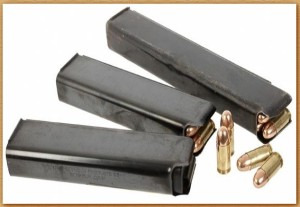 Here is the way I have to look at it: The Bersa 45 UC Pro that I used prior to carrying the Springfield XDs .45 ACP held seven rounds in the magazine plus one round chambered. The Springfield XDs 45 (with standard magazine) holds five rounds with one chambered (the XDs 4.0 45 was my EDC for a while and may be so again at some point in time). The XDs 9mm (standard magazine) holds seven rounds in the magazine with one chambered and, comparably, is more like (capacity-wise) the EDC that is my current choice (a 1911). The XDs 9mm has never been carried, however.
Here is the way I have to look at it: The Bersa 45 UC Pro that I used prior to carrying the Springfield XDs .45 ACP held seven rounds in the magazine plus one round chambered. The Springfield XDs 45 (with standard magazine) holds five rounds with one chambered (the XDs 4.0 45 was my EDC for a while and may be so again at some point in time). The XDs 9mm (standard magazine) holds seven rounds in the magazine with one chambered and, comparably, is more like (capacity-wise) the EDC that is my current choice (a 1911). The XDs 9mm has never been carried, however.
The Bersa and Springfield pistols, unlike a Ruger SR series pistol, do not have magazine disconnects. This means that even if I am in the middle of a re-load I can still get off one chambered round, which could be a game stopper for the bad guy. If I don’t have time to reload after an initial five-round burst, I still have two (Bersa), one (XDs 45), or two (XDs 9mm) rounds to go for a head shot. The odds, of course, are more in my favor should I carry a Beretta 92, Glock G19, or other high-capacity firearm. But, I sometimes carry a compact or sub-compact pistol for the same reasons most of us do – the concealment factor. That means fewer rounds for my immediate use at any time. In short, I have to make the best use of them as possible.
We are taught to shoot until the threat is stopped. Unfortunately, and under stress with both villain and good guy, nobody is usually counting fired rounds. It may take one or it may take twenty rounds to stop the threat. And, that is even considering that all shots hit the target.
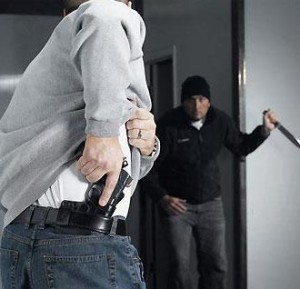 Before I proceed further, I would like to put something into perspective. During my LEO training in the Tueller Drill (see, REFERENCES: Tueller Drill: Defensive Tactics Technique), there was not one officer (including myself) who could clear their PDA (Personal Defense Assistant) from a security holster and get off the first critical-hit shot in 1.5 seconds. A term was coined during training that became known as the “Stitch in Nine.” This term originated in the fact that most officers were already shooting toward the BG when the firearm cleared the holster and the pistol was level to the target; the first shot hit low while subsequent shots climbed up the body much like stitching a piece of cloth. The only way that we were able to get multiple shots center mass was to have the firearm already drawn in high-ready position while trying to get distance between us and the BG at a distance of seven yards. The reality was that even at fifteen yards, we had better have our weapon drawn and at high-ready if not already on the BG. The BG’s objective is to close the gap and kill you; your objective is to increase the gap, survive, and double-taps may not cut it. I will admit that my “Stitch in Nine” (or in my case, the “Stitch in Forty-Five”, as I was the only one that carried .45ACP in the department at that point in time) was never effective until I could get the pistol up to approximate eye level; an affliction that I still suffer to this day. “Stitching” is one area where a good laser might help me. But, I digress.
Before I proceed further, I would like to put something into perspective. During my LEO training in the Tueller Drill (see, REFERENCES: Tueller Drill: Defensive Tactics Technique), there was not one officer (including myself) who could clear their PDA (Personal Defense Assistant) from a security holster and get off the first critical-hit shot in 1.5 seconds. A term was coined during training that became known as the “Stitch in Nine.” This term originated in the fact that most officers were already shooting toward the BG when the firearm cleared the holster and the pistol was level to the target; the first shot hit low while subsequent shots climbed up the body much like stitching a piece of cloth. The only way that we were able to get multiple shots center mass was to have the firearm already drawn in high-ready position while trying to get distance between us and the BG at a distance of seven yards. The reality was that even at fifteen yards, we had better have our weapon drawn and at high-ready if not already on the BG. The BG’s objective is to close the gap and kill you; your objective is to increase the gap, survive, and double-taps may not cut it. I will admit that my “Stitch in Nine” (or in my case, the “Stitch in Forty-Five”, as I was the only one that carried .45ACP in the department at that point in time) was never effective until I could get the pistol up to approximate eye level; an affliction that I still suffer to this day. “Stitching” is one area where a good laser might help me. But, I digress.
 One of the main points brought out in the video “Tueller Drill: Defensive Tactics Technique:” (Refer to REFERENCES: for this one.) was the “Bleed-Out” factor. I was taught that 10 to 15 seconds was the average “bleed out” time. Although the figures might differ from the video, the fact remains that the BG might be still pressing the attack after being shot – even after a direct hit to the heart. As a frame of reference, I still have autopsy photos of a young man who was shot twenty-one times by two police officers before he “decided” to expire (meaning, bled out) from his wounds. The young man was drugged out to the max on PCP and probably did not feel the affects of being shot. Imagine meeting a person like this while you are shopping at Wal-Mart. Even in this case, terminal accuracy doesn’t count for much in the short run (like at seven yards).
One of the main points brought out in the video “Tueller Drill: Defensive Tactics Technique:” (Refer to REFERENCES: for this one.) was the “Bleed-Out” factor. I was taught that 10 to 15 seconds was the average “bleed out” time. Although the figures might differ from the video, the fact remains that the BG might be still pressing the attack after being shot – even after a direct hit to the heart. As a frame of reference, I still have autopsy photos of a young man who was shot twenty-one times by two police officers before he “decided” to expire (meaning, bled out) from his wounds. The young man was drugged out to the max on PCP and probably did not feel the affects of being shot. Imagine meeting a person like this while you are shopping at Wal-Mart. Even in this case, terminal accuracy doesn’t count for much in the short run (like at seven yards).
My point behind all of this is that regardless of what I carry, I cannot rely on statistics to save me. The best that I can do is to train around my EDC of choice, and hope for the best outcome in real life. I don’t care much for statistics, but I sure care about becoming one.
Another point is that I just may have to perform a “combat” reload between “Act” and “Observe” in my personal OODA loop. To do so efficiently and as quickly as possible is highly beneficial.
Currently, I am carrying a “Government” model 1911-based pistol with an eight-round capacity (nine rounds if I top the magazine off). I have several drills that I run that are based on this capacity. However, I don’t want to get locked into a “capacity” frame of mind. Rather, I want to understand the limitations that my current EDC places on me and train accordingly – regardless of what EDC is being carried.
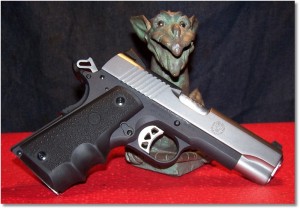 When I ran the Bare Bones Gunfighting course a while back, I was constantly doing combat reloads with the Ruger SR1911CMD-A (more so than others), with a full chamber, regardless of how many rounds were actually fired during the drill. If I only fired two rounds, the magazine was replaced with a fresh one and the partially expended magazine was placed into my vest pocket. Sometimes; however, I would not do a combat reload and simply let the already mounted magazine run out. In training, I had the luxury of deciding when to switch out the magazine. In real life: however, that decision is not a luxury and I noted that to myself. If I emptied a magazine during the course of fire, I performed a standard reload and the empty magazine was dropped on the ground. This has just become habit with me. If I was not wearing a vest, the partially expended magazine would be placed inside the waistband near my magazine pouch and a fresh magazine would then be grabbed and loaded into the pistol – I don’t throw away partially loaded magazines.
When I ran the Bare Bones Gunfighting course a while back, I was constantly doing combat reloads with the Ruger SR1911CMD-A (more so than others), with a full chamber, regardless of how many rounds were actually fired during the drill. If I only fired two rounds, the magazine was replaced with a fresh one and the partially expended magazine was placed into my vest pocket. Sometimes; however, I would not do a combat reload and simply let the already mounted magazine run out. In training, I had the luxury of deciding when to switch out the magazine. In real life: however, that decision is not a luxury and I noted that to myself. If I emptied a magazine during the course of fire, I performed a standard reload and the empty magazine was dropped on the ground. This has just become habit with me. If I was not wearing a vest, the partially expended magazine would be placed inside the waistband near my magazine pouch and a fresh magazine would then be grabbed and loaded into the pistol – I don’t throw away partially loaded magazines.
The point that I am heading toward is that regardless of your EDC, you need to train around your EDC, understand the limitations of your EDC, and use the ADDIE (Analyze, Design, Develop, Implement, and Evaluate) model to best work with the EDC to your advantage. In closing, we have to adapt to the gun, because it does not adapt to us.
REFERENCES:
- Boyd’s Cycle (OODA): Defensive Tactics: https://www.youtube.com/watch?v=ji6z-0H2FG0
- Tueller Drill: Defensive Tactics Technique: https://www.youtube.com/watch?v=-R6Spd-qbsw
- The Mozambique Drill: http://jeffcoopersmozambiquedrill.blogspot.com/
![]()


